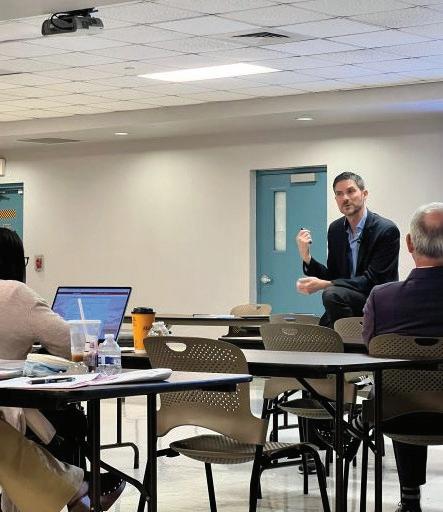
2 minute read
HOW CULTURE INFLUENCES RORSCHACH TESTS AND PSYCHOLOGY
Latinos tend to see more color than non-Latinos,” with color considered a measure of emotional expression and emotional regulation, he says. Non-Latino whites in the US tend to see more movement in the inkblots, he adds.
Back in the 1960s, a doctor from Puerto Rico started a university to explore cultural aspects of psychology, concerned that U.S. schools were neglecting that key variable to understand the human mind.
Advertisement
Now, an international group based in Paris has launched an institute to delve into cultural aspects of Rorschach inkblot tests, recognizing that cultural contexts play an important role in evaluating how a person thinks and helping find the best therapies for specific patients.
Both groups joined forces in South Florida in February, when the president of the International Rorschach Institute offered a two-day workshop at the Doral campus of Albizu University, his first such talk in the United States. About 100 clinicians and students attended the session led by Dr. Patrick Fontan and coordinated by Albizu professor Dr. Ted Cunliffe, a fellow researcher into culture and psychology. Fontan and Cunliffe have been collaborating for years, often publishing research together.
“Psychological testing concerns the comparison of an individual’s score on the test to a representative sample,” explains Cunliffe. What the International Rorschach Institute has done is create a growing database of Rorschach scores from roughly 30,000 people from 27 countries, including people identifying as U.S. Latinos. With its new software, a psychologist can compare scores by country, ethnicity and other factors to better gauge norms and make recommendations for patients. Says Cunliffe, “The breadth of this sample is unlike any that exists for any other psychological test.”
Rorschach results vary widely by culture – among Spanishspeaking nations and even between such Caribbean islands as Puerto Rico and Cuba. Still, some broad differences emerge between Hispanics and non-Latino U.S. whites in how viewers see the inkblots, Cunliffe says. “In general,
At issue are psychology tests developed by Swiss psychiatrist and psychoanalyst Hermann Rorschach in 1921, shortly before his death. They ask viewers to describe what they see in inkblots on cards. Researchers came up with varied ways to interpret results, which then were synthesized starting in the 1970s by American psychologist Dr. John Exner in what’s called the “comprehensive system” and widely used. After Exner’s death in 2006, an international group – with support from Exner’s family - began updating his system. They founded the International Rorschach Institute in Paris two years ago, keen to “compare scores to the norms of a country,” says Fontan, “because the context you live in also shapes your personality and how you see the world.”
Fontan says the Rorschach test typically involves 10 cards and takes about an hour to complete. Researchers do not focus interpretation on a specific word that a viewer may use, but rather look at “the shape of their perception,” says Fontan. For example, if a viewer sees an inkblot as a bat wounded or a bat flying, or if they see a two-sided picture as weighted to one way or another, those perceptions have different meanings and spark different scores. About 100 scores come out of one viewer’s test, items evaluated by trained clinicians to help with “treatment planning,” says Fontan.
The Feb. 24-25 workshop examined multiple ways to analyze samples of Rorschach data, such as using regression models that might predict the risk of suicide in one country compared to others. It also discussed different approaches to psychology, such as understanding people based on personality categories or based on multiple dimensions including how extroverted or how empathetic they are. Fontan says it takes at least a year of weekly training for clinicians to analyze Rorschach tests effectively.
Albizu University mainly serves Hispanic adults studying psychology and counseling. Dr. Carlos Albizu started the school in Puerto Rico in 1966 to infuse cultural sensitivity into the psychology curriculum. The school is billed as the only university in the United States named for a Hispanic.

Electric Cars +









